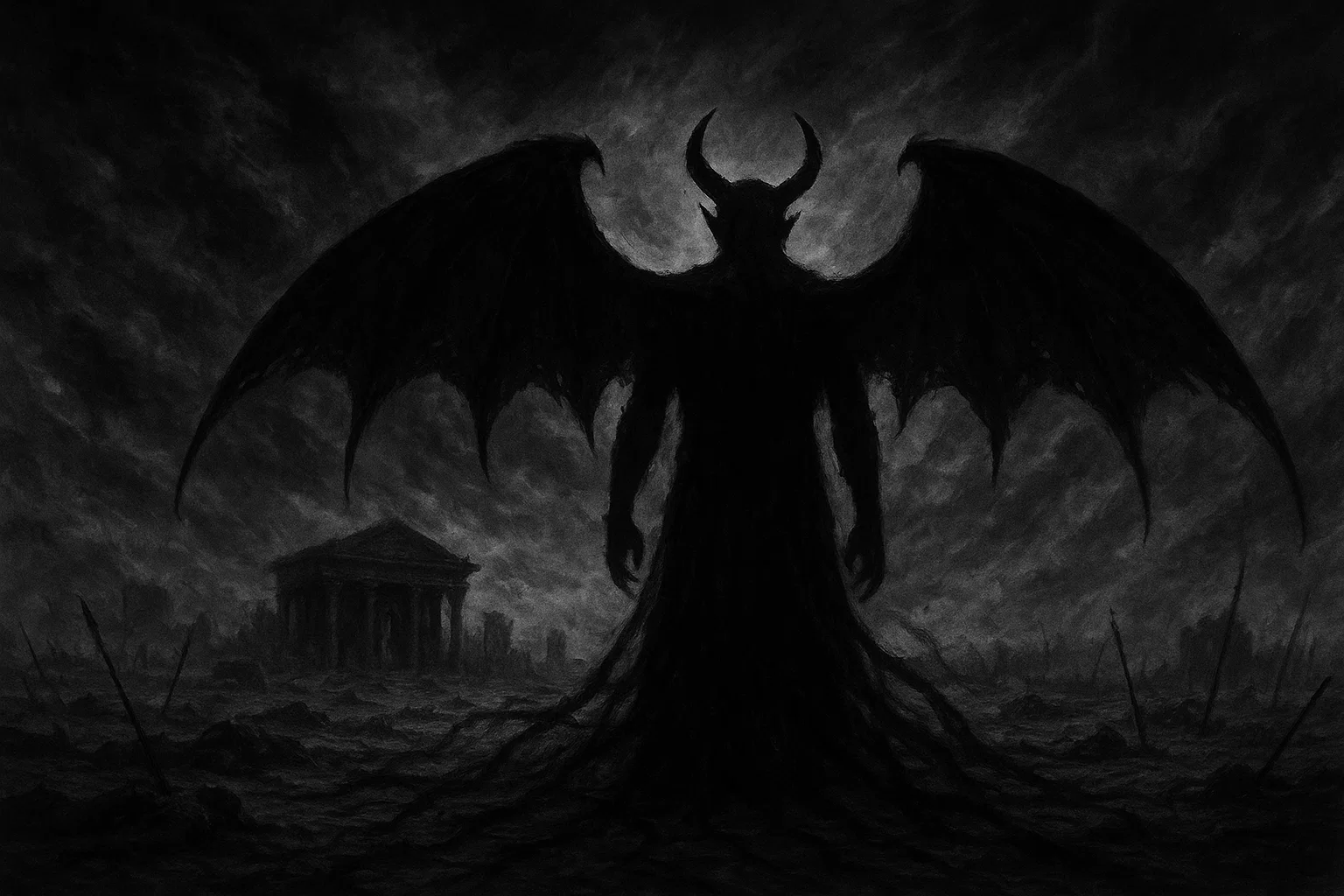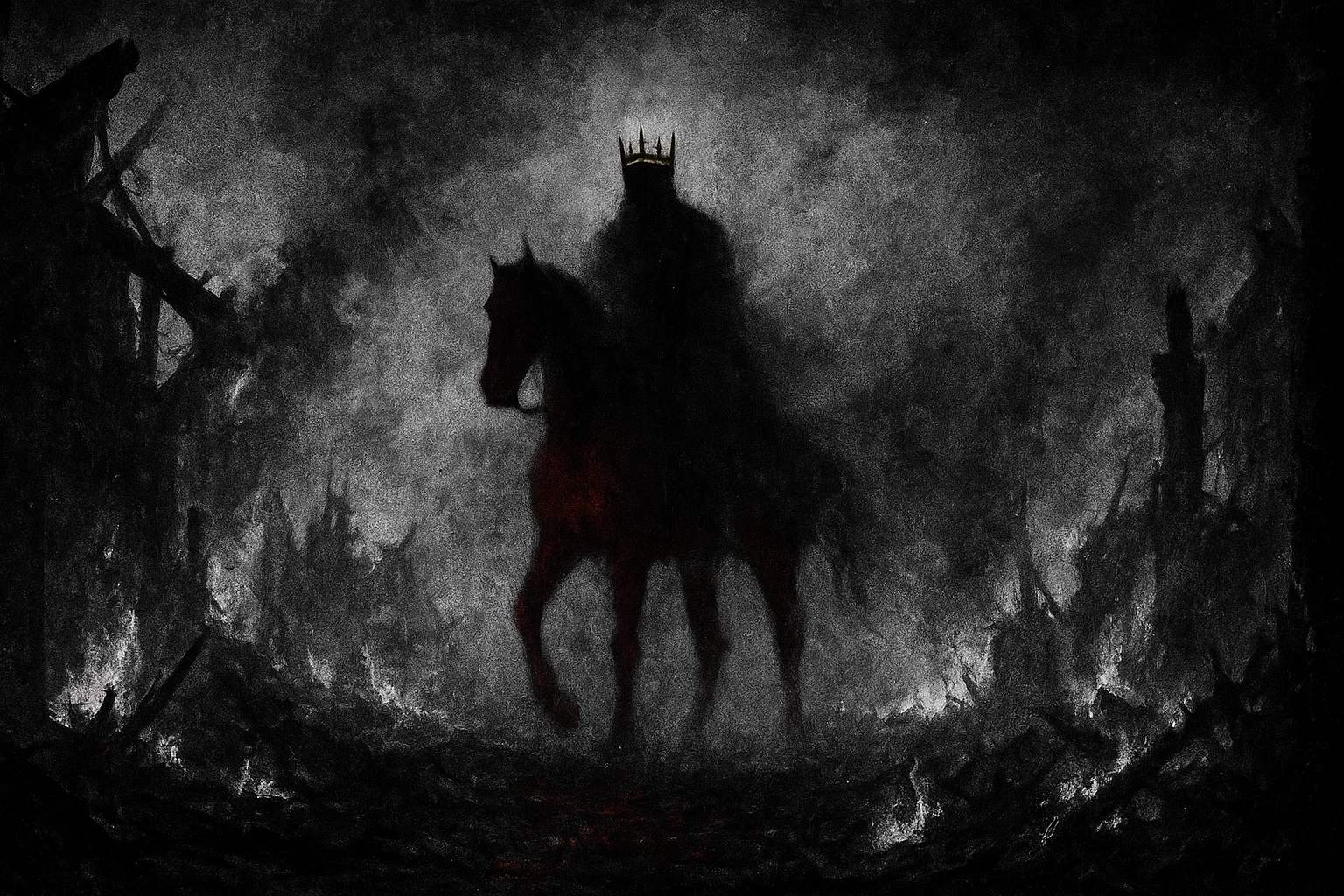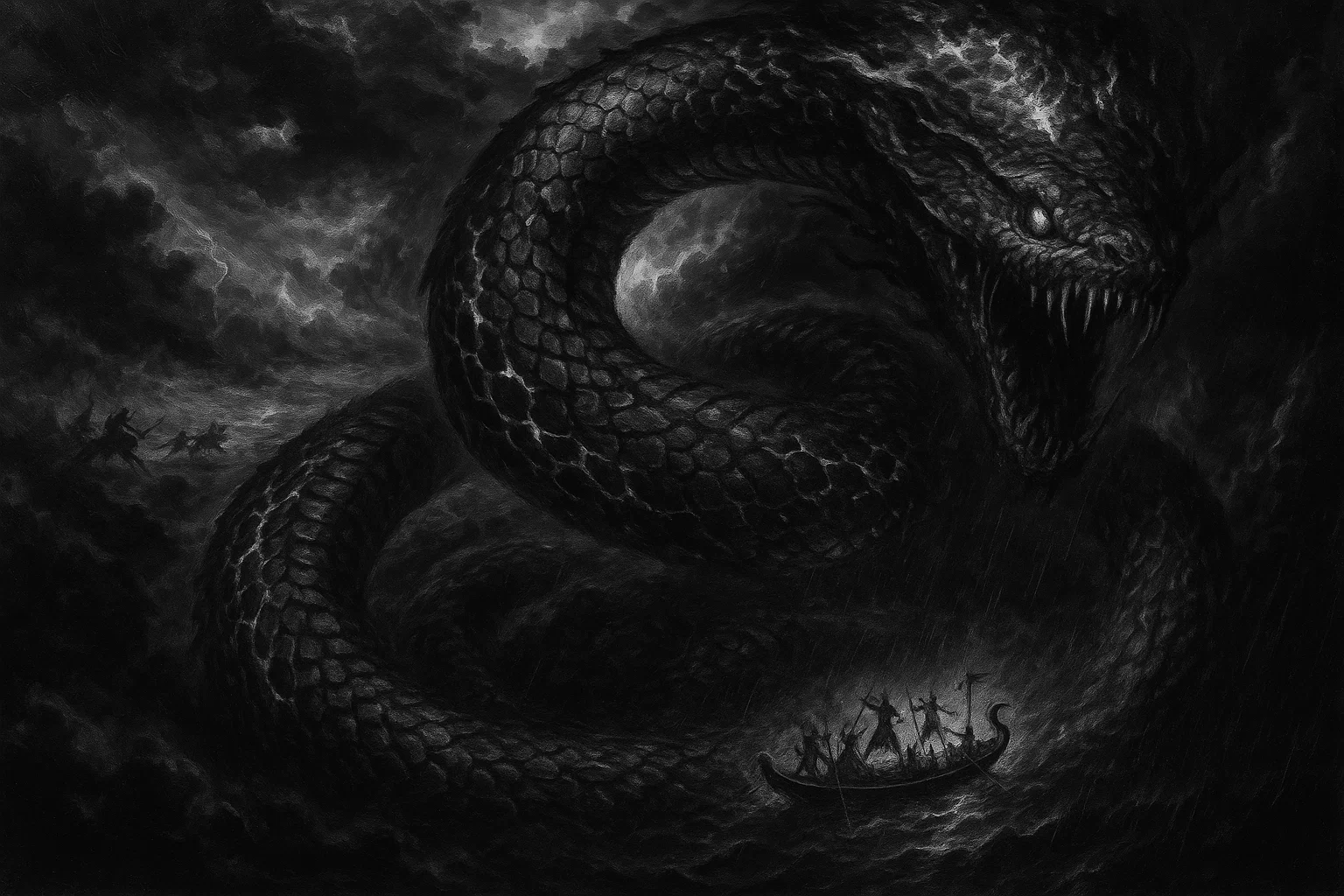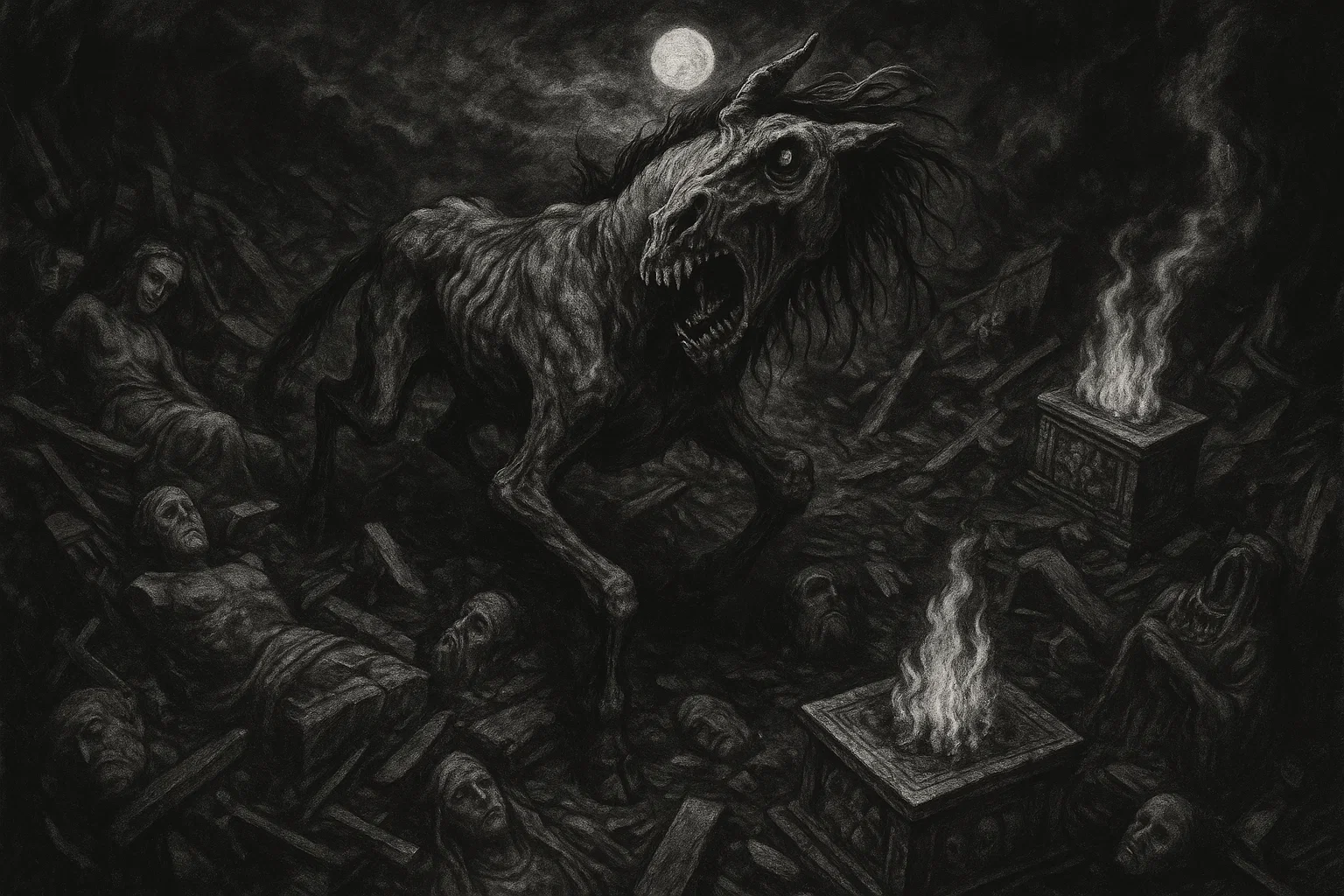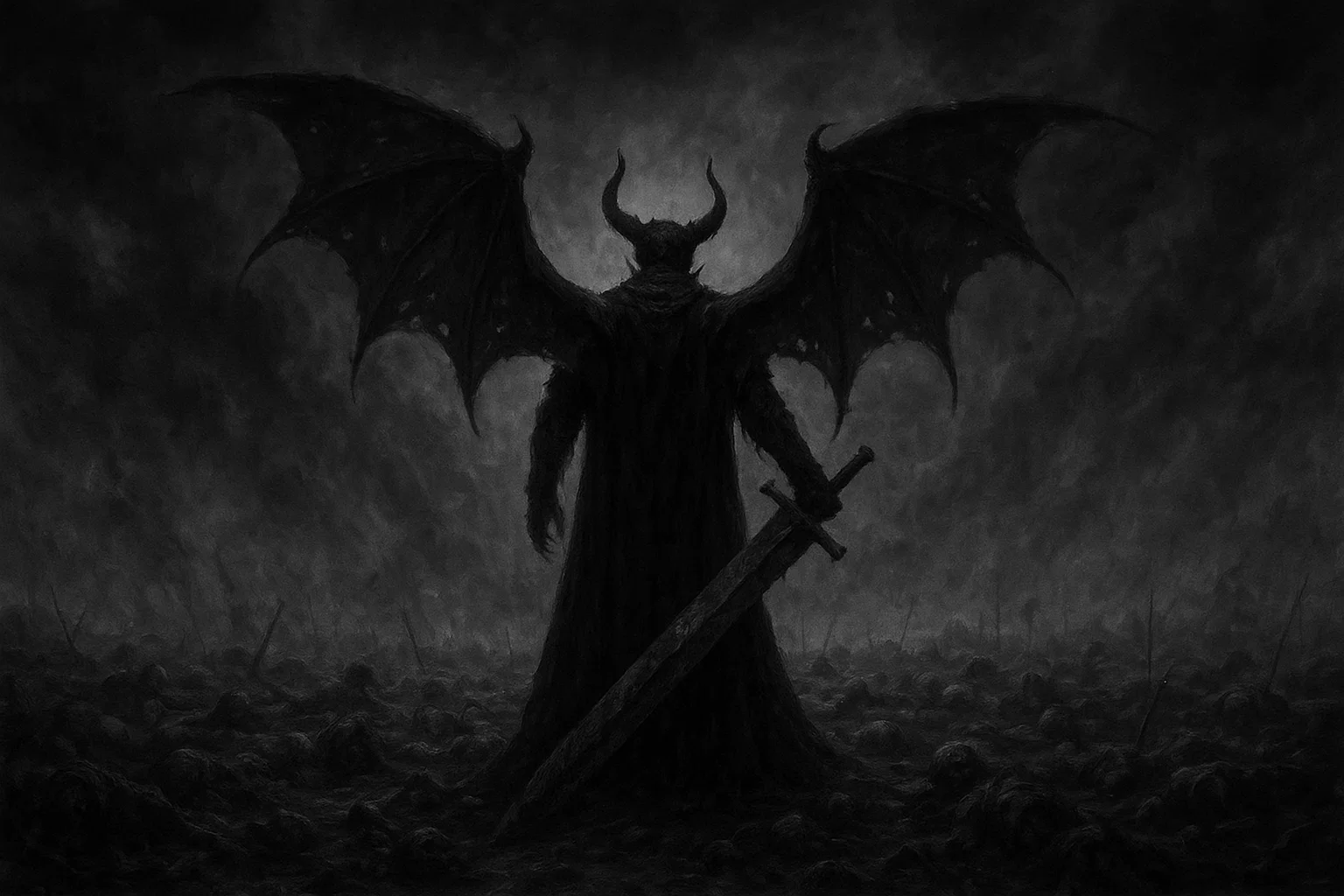In the shadowed recesses of ancient Persian mythology, Ahriman, the malevolent force of chaos and destruction, wages an eternal war against the radiant order of creation.
Known as Angra Mainyu in the sacred texts of Zoroastrianism, this demon embodies the essence of evil, weaving a tapestry of deceit, corruption, and ruin that challenges the divine harmony of Ahura Mazda, the supreme god of light.
Ahriman is no mere villain; he is the cosmic adversary, the architect of plagues, winter, and moral decay, whose influence tempts humanity to stray from righteousness. What drives this relentless spirit to oppose all that is good? How does his sinister legacy ripple through ancient myths and modern interpretations? And can humanity resist his insidious whispers in the battle for cosmic balance?
This exploration delves into the heart of Ahriman’s dark dominion, unraveling his origins, powers, and enduring role as one of mythology’s most formidable antagonists.
Table of Contents
Key Information
| Attribute | Details |
|---|---|
| Name | Ahriman, Angra Mainyu, Aŋra Mainiiu, Ahrimanes, The Destructive Spirit |
| Title | Lord of Darkness, Prince of Destruction, Evil Spirit, Adversary of Ahura Mazda, Creator of Daevas |
| Gender | Male |
| Role | Embodiment of evil, chaos, and destruction; tempter of humanity; counter-creator opposing divine order |
| Hierarchy | Supreme leader of evil forces in Zoroastrian cosmology; head of the daevas (demons); in Zurvanite tradition, twin brother to Ahura Mazda but subordinate in ultimate power |
| Servitors | Daevas such as Aka Manah (Evil Mind), Indar (Indra, demon of false gods), Saurva (Taurvi, demon of violence), Naonhaithya (Naunghaithya, demon of discontent), Aeshma (wrath demon), Bushyasta (sloth demon), Azhi Dahaka (three-headed dragon) |
| Superior Demon | None in standard Zoroastrianism (independent evil principle); in Zurvanism, Zurvan (Time) as the neutral father of both Ahriman and Ahura Mazda |
| Powers | Creation of plagues, diseases, winter, and natural disasters; temptation through deception, anger, greed, and lust; ability to corrupt creation and inspire evil thoughts in humans |
| Appearance | Often depicted as a shadowy, formless entity of darkness; sometimes as a leontocephaline figure (lion-headed with serpentine elements); associated with foul smells, cold, and decay |
| Etymology | Derived from Avestan “Angra Mainyu,” meaning “destructive spirit” or “hostile mentality” |
| Associated Figures | Ahura Mazda (opponent and counterpart), Spenta Mainyu (holy spirit brother), Zoroaster (prophet who resists him), Daevas (his creations), Azhi Dahaka (his monstrous servant) |
| Weaknesses | Defeated by good thoughts, words, and deeds; vulnerable to Ahuna Vairya prayer; destined for ultimate destruction by Ahura Mazda at Frashokereti (renovation of the world) |
| Opposing Angel/Saint | Ahura Mazda, Spenta Mainyu; in broader terms, the Amesha Spentas (immortal holy ones) like Asha (truth) and Vohu Manah (good mind) |
| Equipment/Tools | No specific tools; associated with witchcraft, serpents, and instruments of chaos like the creation of winter or plagues |
| Pantheon | Zoroastrian (ancient Iranian religion) |
Etymology
The name Ahriman derives from the Avestan term Angra Mainyu, a phrase that encapsulates his essence as the “destructive spirit” or “hostile mentality.” The word angra stems from Proto-Indo-Iranian roots, meaning “tight,” “constricted,” or “hostile,” suggesting a force that binds or strangles creation.
Mainyu refers to a spirit, mind, or abstract mental force, emphasizing Ahriman’s role as a malevolent intelligence rather than a mere physical entity. In the Gathas, the oldest hymns of Zoroastrianism attributed to the prophet Zoroaster (c. 1500–1000 BCE), Angra Mainyu appears as a descriptive epithet for the principle of evil, not yet a formalized name.
By the Middle Persian (Pahlavi) period (c. 3rd–7th centuries CE), the term evolves into Ahriman, a personified entity, often written upside down in scripts to signify contempt and his inversion of divine order.
This linguistic evolution reflects Ahriman’s transformation from an abstract concept to a central figure in Zoroastrian demonology. Comparative linguistics ties angra to Sanskrit anghra (narrow or oppressive), hinting at shared Indo-Iranian concepts of malevolent constriction. In later Greek accounts, such as those by Plutarch (c. 46–120 CE), Ahriman becomes Areimanios, a name used in Mithraic cults, blending Persian and Hellenistic influences.
This cross-cultural adaptation underscores Ahriman’s enduring identity as the antithesis of creative thought, a force that seeks to unravel the fabric of existence. His name also connects to broader Indo-European mythologies, where chaos deities like the Vedic Vritra (meaning “obstructor”) share similar etymological roots, suggesting a deep-seated archetype of opposition to cosmic order.
You May Also Like: Who Is Abezethibou? The Fallen Angel of the Red Sea
What Does the Demon Ahriman Look Like?
Ahriman’s form is elusive in Zoroastrian texts, reflecting his nature as a pervasive, intangible force of darkness rather than a corporeal being. He is often described as a shadowy entity, emanating cold, decay, and a foul odor that symbolizes corruption.
In Pahlavi literature, such as the Bundahishn, he is associated with blackness, old age, and a withered presence, evoking a malevolent gloom that suffuses the world.
Some artistic depictions, particularly in syncretic Mithraic cults, portray Ahriman as a leontocephaline figure—a lion-headed being entwined with serpentine coils, symbolizing his predatory and chaotic essence. This imagery aligns with his creation of monstrous servants like Azhi Dahaka, a three-headed dragon with six eyes and a thousand senses, suggesting Ahriman himself may embody multifaceted malice.
In ritual contexts, Ahriman’s presence is felt through sensory cues: the chill of winter, the stench of decay, or the oppressive weight of darkness. These abstract qualities reinforce his role as the lord of disorder, a demon whose influence is more atmospheric than physical, seeping into the world to corrupt rather than confront directly.
Historical and Mythological Background
Ahriman’s origins lie at the heart of Zoroastrian cosmology, a dualistic system where he stands as the eternal adversary to Ahura Mazda, the wise lord of creation. Emerging from ancient Iranian beliefs (c. 2nd millennium BCE), Ahriman represents the destructive force in a universe divided between light and darkness. His role is not merely to oppose but to actively undermine creation, making him a central figure in myths that explore the moral and cosmic struggle between good and evil.
Origins and Connections to Other Deities and Demons
Ahriman’s roots trace back to Proto-Indo-Iranian traditions, where dualistic concepts of order versus chaos were prevalent. In Zoroastrianism, he is an uncreated principle, existing coeternally with Ahura Mazda but inferior in wisdom and foresight.
In the Zurvanite heresy, a variant of Zoroastrianism, Ahriman and Ahura Mazda are twin sons of Zurvan (Time), with Ahriman emerging first due to Zurvan’s doubt, granting him temporary dominion. This narrative parallels other dualistic mythologies, such as the Manichaean conflict between the Father of Greatness and the Prince of Darkness, where Ahriman’s influence is evident.
Comparatively, Ahriman shares traits with other chaos deities across world mythologies:
- Vritra (Vedic Hinduism): A serpentine demon who obstructs cosmic waters, akin to Ahriman’s disruption of creation with salt and drought. Both embody resistance to divine order, though Vritra is a physical beast slain by Indra, while Ahriman is an eternal spirit.
- Set (Egyptian Mythology): A god of chaos and storms who opposes Osiris and Horus, similar to Ahriman’s opposition to Ahura Mazda. Set’s association with deserts and sterility mirrors Ahriman’s creation of barrenness.
- Typhon (Greek Mythology): A monstrous force of chaos who challenges Zeus, much like Ahriman’s assault on the divine sky. Both are linked to serpentine imagery and cosmic disruption.
- Loki (Norse Mythology): A trickster god whose actions precipitate Ragnarök, paralleling Ahriman’s role in inciting apocalyptic conflict at Frashokereti. However, Loki’s motivations stem from mischief, while Ahriman’s are rooted in pure malice.
- Satan (Abrahamic Traditions): Like Ahriman, Satan is a tempter and adversary, but his role as a fallen angel contrasts with Ahriman’s uncreated nature, emphasizing Zoroastrianism’s unique dualism.
These connections highlight Ahriman’s archetype as a universal symbol of chaos, adapted across cultures but distinctly eternal and unyielding in Zoroastrianism.
You May Also Like: Abalam: Demon of Sorrow and Knowledge
The Cosmic Assault on Creation
In the Bundahishn (c. 9th century CE), Ahriman emerges from the abyss of darkness, ignorant of Ahura Mazda’s light until the act of creation reveals it. Enraged, he vows to corrupt all that is good, smashing into the sky like a serpent, polluting waters with salt, and introducing death, disease, and sin.
For every benevolent act of Ahura Mazda—creating light, plants, animals—Ahriman counters with darkness, thorns, and predators. This cosmic assault sets a 9,000-year pact, limiting Ahriman’s reign and foretelling his defeat at Frashokereti, the world’s renovation. This myth underscores Zoroastrianism’s optimistic view that evil, though powerful, is temporary.
The Creation of Azhi Dahaka
One of Ahriman’s most infamous acts is forging Azhi Dahaka, a three-headed dragon described in the Yasna as a lie-demon with six eyes and a thousand senses. Crafted to ravage settlements and embody deception, Azhi Dahaka becomes a symbol of tyranny, later bound by the hero Thraetaona in the Shahnameh (c. 10th century CE).
The dragon’s creation tempts humans toward power and falsehood, reflecting Ahriman’s strategy of indirect corruption. In some tales, Azhi Dahaka recoils from divine forces like Mithra’s mace, revealing Ahriman’s creations’ vulnerabilities.
Temptation of Zoroaster
In the Vendidad, Ahriman confronts Zoroaster, offering worldly sovereignty to renounce Ahura Mazda. Zoroaster resists, reciting the Ahuna Vairya prayer, which stuns Ahriman and repels his daevas, such as Buiti, the demon of false religion.
This encounter emphasizes Ahriman’s reliance on temptation, targeting the prophet’s free will to undermine divine truth. Zoroaster’s triumph serves as a model for Zoroastrians, highlighting the power of purity and sacred words against Ahriman’s deceptions.
Battles with Yazatas
Ahriman engages in episodic conflicts with yazatas (benevolent beings). In Yasht 8, he battles Tishtrya, the star of rain, attempting to withhold precipitation and cause drought.
Tishtrya triumphs through human sacrifices, restoring fertility. In another tale, the Fravashis (guardian spirits) thwart Ahriman’s plans to dry the earth, protecting creation’s vitality. These battles depict Ahriman as a persistent but ultimately futile antagonist, whose schemes are countered by divine and human cooperation.
The Seductress Jeh
In the Bundahishn, Ahriman creates Jeh, a primal demoness, to afflict women with menstruation and seduce men into lust. Her kiss awakens Ahriman’s own desires, enabling further corruption.
Jeh’s role ties Ahriman to biological and social decay, exploiting human frailties to propagate evil. This myth reflects Zoroastrian anxieties about purity and gender, with Jeh as a tool to disrupt divine harmony.
The Final Defeat at Frashokereti
Zoroastrian eschatology foretells Ahriman’s annihilation at Frashokereti, the cosmic renovation. Ahura Mazda, aided by the savior Saoshyant, purifies creation with molten metal, consuming Ahriman’s essence in his own rage.
The dead are resurrected, and the world is restored, affirming Ahriman’s ultimate futility against divine justice. This apocalyptic vision offers hope, positioning Ahriman as a temporary force destined for obliteration.
You May Also Like: Sallos: The Mysterious Demon of Love
Cultural and Historical Context
Ahriman’s myths evolved across Zoroastrian texts, from the Avesta (c. 1000–600 BCE) to Pahlavi works like the Denkard and Book of Jamaspi (c. 9th–11th centuries CE).
His role reflects ancient Iranian concerns about moral choice, environmental crises, and cosmic balance. His influence extended to neighboring cultures, appearing in Manichaean texts as the Prince of Darkness and in Mithraic mysteries as Areimanios.
In medieval Persian folklore, Ahriman’s legacy persisted in tales of sorcery and demonic temptation, shaping Islamic demonology in works like the Shahnameh.
Ahriman’s Powers and Abilities
Ahriman’s powers are rooted in Zoroastrian dualism, focusing on counter-creation, mental corruption, and cosmic disruption. Unlike demons who possess or torment, Ahriman systematically opposes Ahura Mazda’s order by introducing specific evils—plagues, winter, unbelief—that exploit human free will. His abilities emphasize long-term decay, making him a master of insidious influence.
| Power/Ability | Description | Source | How It Tempts/Corrupts Humans | Countermeasure |
|---|---|---|---|---|
| Counter-Creation | Creates opposing forces like plagues, winter, thorns, and monsters to undo Ahura Mazda’s work | Vendidad | Instills despair, prompting selfish survival instincts | Ahuna Vairya prayer; good deeds promoting Asha (truth) |
| Mental Corruption | Inspires evil thoughts (aka manah), lies, and unbelief, clouding minds with doubt | Yasna | Encourages renunciation of morality for power, as seen with Zoroaster | Adherence to Vohu Manah (good mind); Spenta Mainyu’s guidance |
| Creation of Daevas | Summons demons like Aka Manah (evil mind), Aeshma (wrath), Bushyasta (sloth) to embody vices | Bundahishn | Amplifies flaws like anger or laziness, eroding societal harmony | Invocation of Amesha Spentas; purification rituals |
| Natural Disasters | Brings drought, heat, or pestilence to disrupt life | Yasht | Fosters greed and conflict over resources | Sacrifices to Tishtrya; communal prayers |
| Biological Corruption | Introduces sins like lust or menstruation via Jeh | Bundahishn | Exploits physical desires to distract from spiritual growth | Zoroastrian purity laws; devotion to Armaiti |
| Illusion and Deception | Crafts false realities or visions to mislead | Denkard | Sows confusion, leading to false worship or moral lapses | Clarity through Asha and ritual focus |
| Necromancy and Decay | Animates corpses or spreads decay to mock life | Pahlavi texts | Instills fear of death, weakening resolve | Fire ceremonies; faith in Frashokereti |
| Modern Pop Culture Powers | In media like Shin Megami Tensei or Prince of Persia, manipulates time, possesses technology, or warps reality | Video games, novels | Appeals to modern fears of technological overreach or moral ambiguity | Critical thinking; adherence to traditional virtues |
Expanded Powers in Modern Contexts
In contemporary pop culture, Ahriman’s powers are reimagined to resonate with modern anxieties. In the Shin Megami Tensei series, he wields dark magic and reality-warping abilities, reflecting fears of existential chaos. In Prince of Persia: The Two Thrones, Ahriman manipulates time and possesses artifacts, symbolizing control over fate.
These adaptations amplify his traditional role as a tempter, extending his influence to digital realms and psychological horror, where he exploits fears of technology and moral relativism. While not canonical, these portrayals draw on Ahriman’s core ability to corrupt through doubt and illusion, adapting his ancient menace to modern narratives.
Ahriman’s Role in the Hierarchy of Hell
In Zoroastrian cosmology, Ahriman reigns as the supreme leader of evil forces, not within a Christian “hell” but in a dualistic universe where he commands the abyss of darkness. He is the uncreated principle of destruction, equal in origin to Ahura Mazda but inferior in wisdom.
In standard Zoroastrianism, Ahriman has no superior, standing alone as the architect of chaos. In Zurvanite tradition, Zurvan (Time) is the neutral father, but Ahriman’s dominion remains unchallenged among evil entities.
You May Also Like: Who Is the Demon Gremory in Ars Goetia?
Domain and Armies
Ahriman rules the spiritual abyss, a formless realm of darkness and cold, described in the Bundahishn as the void from which he launches assaults on creation. His armies consist of daevas, demonic entities embodying specific vices:
- Aka Manah: Demon of evil mind, inciting deceitful thoughts.
- Aeshma: Demon of wrath, fueling violence and rage.
- Bushyasta: Demon of sloth, inducing lethargy and apathy.
- Saurva: Demon of violence, promoting tyranny.
- Naonhaithya: Demon of discontent, sowing discord.
- Indar: Demon of false gods, encouraging idolatry.
- Azhi Dahaka: A monstrous dragon, symbolizing tyranny and destruction.
These daevas serve as lieutenants, each commanding lesser spirits (druj) that infiltrate human minds and environments. Ahriman’s hierarchy mirrors the divine Amesha Spentas, with each daeva opposing a specific holy immortal (e.g., Aka Manah vs. Vohu Manah).
Notable Relationships
- Superior Demons: None in standard Zoroastrianism; in Zurvanism, Zurvan is a neutral progenitor, not a ruling demon.
- Allied Demons: Ahriman’s daevas are his primary allies, with Jeh as a key collaborator in biological corruption. In syncretic traditions, he aligns with chaos entities like Zohak (a corrupted king in the Shahnameh).
- Adversary Demons: Ahriman has no direct demonic rivals, as his authority over evil is absolute. His adversaries are divine beings like Ahura Mazda, Spenta Mainyu, and the Amesha Spentas.
- Notable Interactions: Ahriman’s battles with Tishtrya, Mithra, and the Fravashis highlight his opposition to divine forces. His temptation of Zoroaster underscores his focus on subverting key human figures.
Ahriman’s hierarchy is unique in its lack of internal competition, emphasizing his role as the singular source of evil. His influence extends to human agents, such as sorcerers or tyrants, who unwittingly serve his cause by spreading discord.
Astrological Associations and Symbolism
Ahriman’s astrological and symbolic associations reflect his chaotic essence, tying him to elements, planets, and motifs that disrupt harmony. In Zoroastrianism, he opposes the benevolence of celestial bodies like the sun and moon, aligning with malefic forces.
| Association | Details |
|---|---|
| Elements | Darkness, cold, corrupted earth, smoke (symbolizing obscured truth) |
| Planets | Saturn (limitation, decay); Mars (violence, conflict) |
| Numbers | 6 (number of primary daevas); 9,000 (years of his reign) |
| Days | Winter solstice (longest night); dark moon phases |
| Metals | Lead (heaviness, corruption); iron (war and destruction) |
| Precious Stones/Crystals | Obsidian (darkness, protection against light); jet (absorption of energy); black tourmaline (negativity) |
| Colors | Black (abyss, corruption); red (wrath, blood); gray (decay, desolation) |
| Zodiac | Capricorn (Saturn-ruled, restriction); Scorpio (transformation to evil); Aquarius (rebellion against order) |
| Animals | Wolf (predatory chaos); serpent (deception); scorpion (venomous betrayal) |
| Plants | Thornbush (counter to divine flora); nightshade (poison, darkness) |
In later syncretic traditions, Ahriman is linked to eclipses, seen as moments when his darkness overshadows divine light. His symbols—serpents, black flames, and thorns—evoke his role as a disruptor of creation’s beauty and vitality.
You May Also Like: Complete Guide to Maine Bigfoot Sightings (1895–2025)
Ahriman’s Sigil
Zoroastrianism avoids formal sigils for Ahriman, as invoking him is taboo. However, Pahlavi scripts sometimes invert his name as a contemptuous mark, symbolizing his opposition to divine order. Modern occult interpretations propose sigils blending Avestan letters with serpentine or flame motifs, used in rare rituals to understand evil’s nature, not to summon or worship.
These apocryphal sigils might feature:
- A coiled serpent encircling an inverted flame, representing chaos consuming light.
- Six-pointed star with jagged edges, symbolizing the six primary daevas.
- A broken circle, denoting Ahriman’s attempt to fracture cosmic harmony.
| Symbol/Item | Association/Meaning | Use in Rituals |
|---|---|---|
| Serpent | Deception, invasion of creation | Binding in exorcisms; protection against temptation |
| Black Flame | Corruption, anti-light | Meditation on duality; repelling evil influences |
| Thornbush | Opposition to divine flora | Acknowledging obstacles in purification rituals |
| Sulfur Incense | Foul odor of decay | Burned to contrast purity in fire ceremonies |
| Wolf/Dragon | Predatory chaos | Imagery for strength against evil forces |
These symbols are used sparingly, often in scholarly or protective contexts, to reflect on Ahriman’s nature without invoking his power.
Comparison with Other Demons
| Demon | Similarities to Ahriman | Differences from Ahriman |
|---|---|---|
| Lucifer | Rebels against divine order; tempts with knowledge | Fallen angel seeking enlightenment; Ahriman is uncreated, focused on destruction |
| Satan | Adversary to god; inspires sin | Tests faith in monotheism; Ahriman counters creation in dualism |
| Beelzebub | Lord of demons; linked to plagues | Rules infernal hierarchy; Ahriman leads cosmic war |
| Asmodeus | Promotes lust and wrath | Specific vice demon; Ahriman encompasses all evil |
| Leviathan | Chaotic sea monster | Biblical beast; Ahriman creates monsters like Azhi Dahaka |
| Lilith | Seductive corruption (via Jeh) | Empowers rebellion; Jeh afflicts biologically |
| Mara (Buddhism) | Tempts with desire and illusion | Targets spiritual enlightenment; Ahriman seeks cosmic ruin |
You May Also Like: The Gashadokuro: Japan’s Giant Skeleton Yokai of Vengeful Spirits
Conclusion
Ahriman, the destructive spirit of Zoroastrianism, stands as a timeless symbol of chaos and corruption, challenging humanity to choose righteousness in the face of temptation. His myths—from the cosmic assault on creation to his defeat at Frashokereti—weave a narrative of struggle and hope, emphasizing the power of free will and divine justice.
As the lord of daevas, creator of Azhi Dahaka, and tempter of Zoroaster, Ahriman embodies the eternal battle between light and darkness, influencing ancient Persian thought and modern interpretations alike.
His legacy reminds us that evil, though pervasive, is destined to perish, urging vigilance and moral strength in a world shaped by duality.

